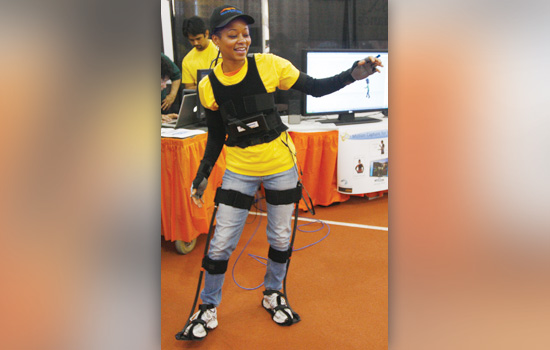Imagine This
Innovation and Creativity Festival Helps Students Succeed
The Virtual Theatre was a 2010 favorite. Technology captures body movement that controls a synthetic actor on a virtual stage.
Imagine RIT: Innovation and Creativity Festival visitors have been dazzled by hot dog-serving robots, world-class artistry and a fleet of energy-efficient vehicles.
The number of visitors has grown from 18,000 in its first year to 32,000 in 2010, its third rendition.
And the festival’s success has helped establish RIT as an innovative university.
But perhaps the biggest beneficiaries of the Imagine RIT experience have been RIT students. The festival has provided them with an outlet to showcase the projects they spend months tinkering with in their dorm rooms to thousands of people.
For students, that experience has proven to be invaluable.
Recognition
Justin Lewis received a surprise when he opened his e-mail inbox in early January. He and fellow students Fran Rogers and Taylor Rose were selected as finalists for Digital Rochester’s inaugural Greater Rochester Excellence and Technology awards.
The award, which they won Feb. 1, wouldn’t have ever happened if the students didn’t present at Imagine RIT.
“It turns out that someone who saw us present at Imagine RIT nominated us,” says Lewis, a fifth-year computer science major from Colchester, Vt.
Digital Rochester, an organization of technology professionals and entrepreneurs, recognized the students for developing their Open Video Chat program, a video messaging system that is used on the One Laptop Per Child initiative’s computers.
The initiative seeks to provide rugged, inexpensive, low-power laptops to children in impoverished areas across the globe. Because its hardware is limited, video chatting is also limited—which makes it difficult for deaf and hard-of-hearing children to use. Open Video Chat has found a way to improve video speed to the point where it can accommodate the use of American Sign Language.
“We didn’t do this to win any awards or receive any attention,” Lewis says. “But this honor shows that other people appreciate our work. It’s a very nice feeling.”
Lewis plans to present at the upcoming festival, but he hasn’t decided what project to feature. Chances are, he says, visitors will find him in RIT’s Center for Student Innovation.
Affirmation
Sarah Duman came to RIT uncertain about which major she’d pursue. She was leaning toward industrial engineering, but hadn’t completely settled on it.
Then she presented at Imagine RIT.
“Imagine RIT really reaffirmed that I was making the right choice. Seeing some of the exhibits that the older students were working on was amazing. I knew I wanted to be in engineering,” says Duman, who is now a second-year student from Cheektowaga, N.Y.
Duman was part of the Women in Engineering exhibit, which aimed to spark an engineering interest in younger students—particularly girls. But it was her experience wandering the festival during her breaks that may have left the most lasting impact.
“There’s a lot of conversation right now among students about whether or not RIT has school spirit beyond the hockey games,” Duman says. “But at Imagine RIT…the amount of people who come together that day show the spirit and creativity that we have. Being able to be a part of that and connecting with my counterparts in other majors and colleges was pretty amazing.”
Duman says she’s anxious to get deeper into her engineering curriculum so that she can create an exhibit that’s as innovative and interesting as many of the upper-class exhibits she witnessed at last year’s festival.
“You know technology is always improving and people are innovating—but I had no idea it was happening in our own backyard until I saw all those students presenting the great things they’ve come up with,” Duman says.
Growth
Presenting a project in front of thousands of people can go a long way toward polishing one’s communication skills, says Nick Sawicky, a fourth-year multidisciplinary studies major.
“At first I was kind of shaky,” Sawicky says of presenting at the inaugural festival in 2008. “But then I got used to it and improved as the day went on. Speaking to crowds of people that I didn’t even know is a great experience to have under my belt.”
And it helped Sawicky prepare for what came next—presenting the Scube, a large cube that people can enter to obtain an immersive learning experience, at conferences across the country.
“We’ve presented in Pasadena, Miami and Washington, D.C. It feels like we’re always on tour,” says the student from Philadelphia.
Sawicky is a part-time student employee in the Department of Imaging Science’s Insight Lab, which developed the Scube. He wants to become a teacher—an ambition that materialized while working on the project.
An added benefit to Imagine RIT, Sawicky says, is the opportunity to see what others at RIT have been working on.
“I was able to hand off the reins a little bit last year and had others do the bulk of the presenting. So I got to see the rest of the festival,” he says. “Seeing what RIT is all about is really cool. There were some amazing projects.”
The Scube will return to Imagine RIT this year. And Sawicky says he’s anxious to show it off to his friends and other visitors.














